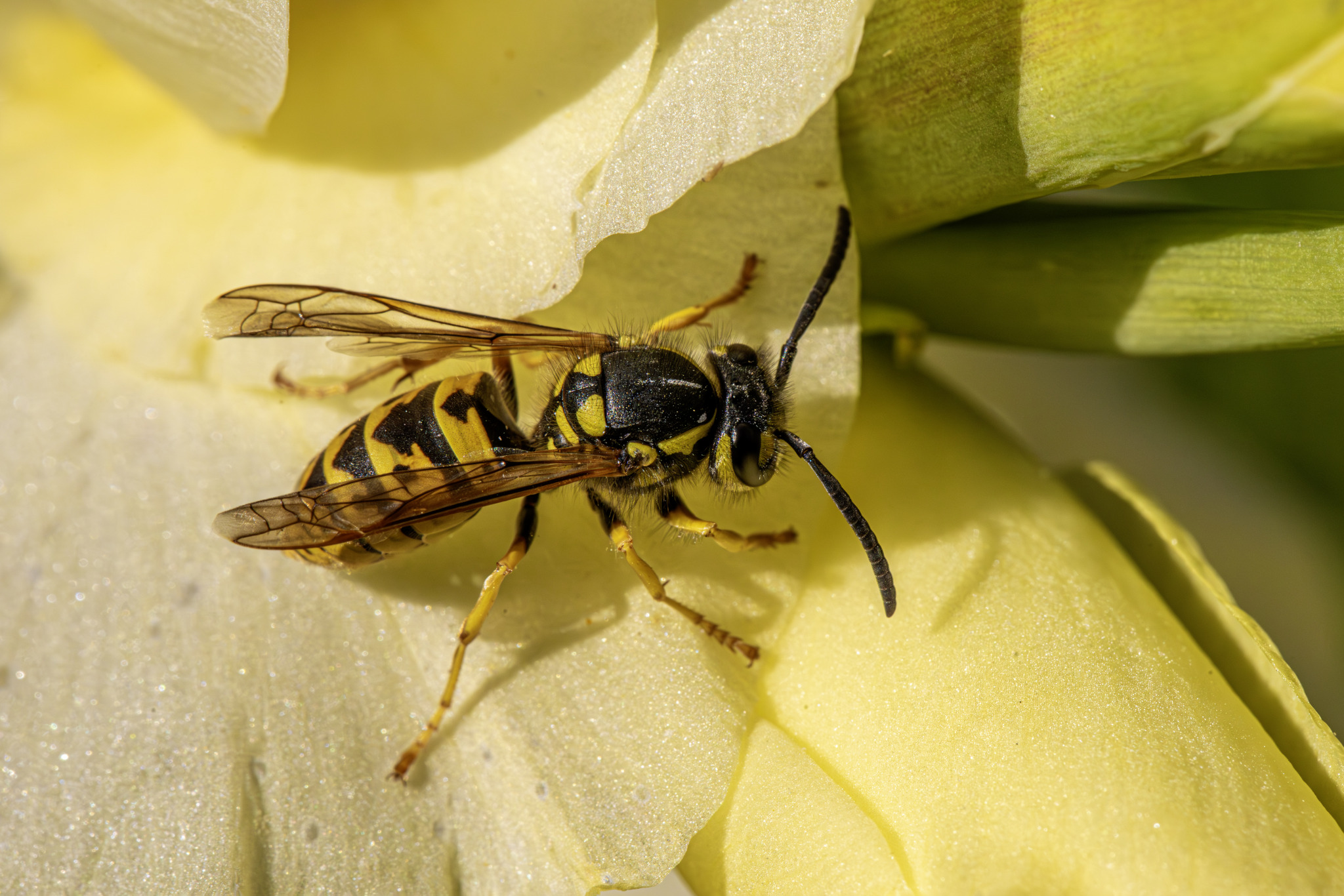The German Yellowjacket (Vespula germanica), also known as the European wasp, is a widely recognized species of social wasp. Known for its aggressive behavior when threatened, it is a common species in Europe, North America, and other regions where it has been introduced.
Description
- Size:
- Workers typically measure between 12 to 15 millimeters in length, while queens are larger, ranging from 16 to 20 millimeters.
- Appearance:
- Coloration: The German Yellowjacket has the characteristic black and yellow striped pattern typical of many wasps. The abdomen is predominantly yellow with black markings, which often include three small black dots on the front of the first abdominal segment, a key identifying feature.
- Head: The face is yellow with black eyes and a pair of antennae. The black dots on the clypeus (the area just above the mandibles) help distinguish it from similar species.
- Wings: The wings are transparent with a slight yellowish tint and are held folded longitudinally over the body when at rest.
Behavior and Ecology
- Habitat:
- German Yellowjackets are adaptable and can be found in a variety of environments, including forests, meadows, urban areas, and gardens. They often build their nests in cavities such as underground burrows, wall voids, or hollow trees.
- Diet:
- Larvae: The larvae are fed chewed-up insects by the workers, primarily caterpillars, flies, and other soft-bodied insects.
- Adults: Adult yellowjackets are primarily attracted to sugary substances, such as nectar, fruit juices, and soda. They also scavenge for protein sources, including dead insects and human food, which makes them common visitors to picnics and outdoor events.
- Nesting:
- The nests are typically constructed from a papery material made by the wasps chewing wood fibers mixed with their saliva. A typical nest can house thousands of wasps and is often located in concealed areas.
- In temperate regions, colonies are annual, with new queens hibernating over winter and emerging in spring to start new nests. The old colony dies off as winter approaches.
- Aggressiveness:
- German Yellowjackets are known for their aggressive nature, especially when defending their nest. Unlike bees, a single yellowjacket can sting multiple times, and they are quick to respond to perceived threats. This behavior makes them one of the more feared and troublesome wasps, particularly in late summer and early autumn when food becomes scarce.
Ecological Role
- Pest Control:
- As predators of various insects, German Yellowjackets play a role in controlling pest populations, particularly caterpillars and other agricultural pests.
- Pollination:
- While not as effective as bees, these wasps do contribute to pollination as they forage for nectar.
Conservation Status
- Distribution:
- Originally from Europe, the German Yellowjacket has become an invasive species in many parts of the world, including North America, Australia, and New Zealand. It is widespread and often considered a pest in many of these areas.
- Conservation:
- There is no conservation concern for this species, given its wide distribution and adaptability. In fact, control measures are often necessary in areas where they have become problematic.
Human Interaction
- Nuisance:
- German Yellowjackets are notorious for their interactions with humans, particularly in late summer when they are more likely to scavenge for food. They are attracted to human food and drink, which can lead to stings if they are disturbed.
- Stings:
- The sting of a German Yellowjacket is painful and can cause allergic reactions in some individuals. Unlike bees, they can sting multiple times, and their aggressive defense of nests makes them a hazard in populated areas.
Summary
The German Yellowjacket (Vespula germanica) is a common and aggressive wasp known for its distinctive yellow and black markings and its ability to thrive in various habitats. While beneficial as a predator of other insects, its tendency to scavenge around human food and its aggressive nature make it a significant nuisance, especially in late summer. Despite this, the species is widespread and adaptable, thriving in regions far beyond its native range in Europe.
Views: 1334
Subscribe to the newsletter:
